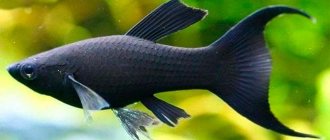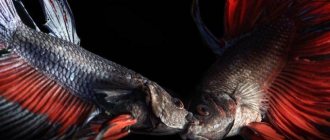The aquarium fish betta is known and popular among aquarists. This species is called betta splendes or fighting fish, it belongs to the labyrinth fish, which are of interest not only for their appearance, but also for their way of life and habits. For beginner aquarists, bettas may seem like a difficult species to keep, as they require special care. The process of reproduction and breeding requires certain knowledge, for example, how female bettas differ from males and how to spawn.
Features of the fish
The fish has interesting features that make it so popular for keeping at home:
- The volume of an aquarium for a betta can be extremely small; an individual will survive even in 1 liter of water (but it is not recommended, because the fish will feel uncomfortable).
- To raise bettas, you do not need an air generator; this species has a unique labyrinth organ that allows them to breathe atmospheric air, so this individual is suitable for keeping in the bedroom and other rooms where you do not want to hear the sound of a running compressor.
- Betta individuals perform interesting and beautiful games during the mating season.
- In order for the female and male rooster to reproduce, they need to create appropriate conditions.
The general requirements for keeping individuals include an optimal water temperature of 27 degrees, acidity from 6.5 to 7.3. Hard old water is not suitable for these fish.
Cockerel fish
Compatibility with other aquarium inhabitants
Cockerels of those varieties that have lush, voluminous fins are not kept with other fish. Neighbors for fighting aquarium inhabitants should be selected carefully; they should be active individuals capable of self-defense. You can add swordtails, speckled catfish, neon rainbowfish, and Siamese algae eaters to the cockerels.
Reproduction
Breeding cockerels consists of four stages: selection of a partner, preparation for spawning, spawning itself, then raising fry. Each stage of fish reproduction is part of one complex system; bettas are capable of reproduction only in a specially created habitat, which, as a rule, is provided inside an artificial reservoir.
The ideal option for further breeding of fish is to keep individuals in a common vessel with a partition. In such an environment, the fish quickly get used to each other and are capable of further breeding. Cockerels reproduce well at a young age.
How to distinguish a male from a female
For successful breeding, it is important to distinguish a male betta from a female. The sex of a betta fish can be determined when it reaches the age of 3 months. During this period, a number of differences already appear between fish of different sexes. In order to determine the sex by color, it is important to know that under favorable conditions, the male will be much brighter and more elegant than the female cockerel. But if the female rooster experienced stress due to a change of place of residence or other human intervention in her life, the color of the female will be no less bright, in which case it will be impossible to distinguish between gender, the male and female will be the same.
Difference between female and male bettas
There is another way to determine the sex of individuals; to do this, you need to pay attention to the fins. Males have larger fins that look like sails; this feature begins to manifest itself especially clearly after 6 months. The older the male, the more beautiful his fins become.
Matching
Reproduction of betta fish begins with the selection of a pair. The fish most suitable for procreation are female and male cockerels from 5 months to 1.5 years. If older individuals reproduce, the risk of problems with the reproductive system increases; in this case, the fry are born with defects, and most of them die.
If there are several female bettas living in an aquarium, they need to purchase a male and vice versa. A pair should be purchased from a breeder, as pet store sellers may not have information about the age and reputation of the individual. They should be purchased at the age of 5 months, not earlier, so that upon purchase you can easily distinguish the gender of the cockerel.
Briefly about the view
Aquarium betta fish are very different from their wild relatives. Breeders have done their best, and now you can find many color and veil variations of this species, which are rightfully considered one of the most beautiful inhabitants of home ponds.
The scales can be painted in a wide variety of colors and shades, and in bright light they all play and shimmer, delighting and bewitching.
Important! More than one male cannot be kept in one container. A larger and stronger male will definitely kill his opponent. Therefore, when buying cockerels, it is so important to clarify the gender of the fish. Ideally, a pair is purchased.
To take a closer look at what the Cockerel fish looks like, look at the photo:
Preparing for spawning
Aquarium bettas are bred without significant difficulties if the required conditions are provided for them. When preparing for spawning, it is important to prepare a special aquarium where the couple should be placed. The aquarium-seater must meet the requirements:
- Be voluminous, with a capacity of at least 40 liters of water.
- There should be a partition inside the vessel to keep the female rooster separate.
- The spawning nest must be suitable for housing eggs and fry, as well as floating vegetation.
- It should have a sponge filter and heating.
- For a comfortable stay of individuals, a water height of 15 centimeters is sufficient;
- The temperature inside the vessel should be between 27–28 degrees.
Before the female begins to spawn, it is important to feed the individuals correctly. 2 weeks before the start of spawning, live food must be included in the diet:
- Worms.
- Crickets.
- Cockroaches.
- Bloodworm.
- Artemia.
The food should be crushed, the amount of food at one time should be equal to the needs of the fish. Excess food should not remain inside the container. A pregnant betta fish also needs a high-quality, varied diet.
A pair of cockerels
It is important to observe the behavior of the couple. A sign of successful spawning will be the pair's obvious interest in each other, excited behavior and demonstration of their appearance. However, if the fish show aggression, it is better to separate such a pair from each other. In such a situation, it is necessary to choose a new pair for them.
Female and male: differences
You can visually identify a male or female from the age of three months. There are several signs that distinguish a female betta fish from a male:
- Female betta fish are slightly smaller in size than males.
- The male individual is distinguished by a luxurious tail, and long fins, reminiscent of sails, with a brighter color in comparison with the fins of chickens.
Interesting: If a female cockerel was under stress, for example due to a change in environment, her color may become as bright as that of a male. In this case, it is almost impossible to determine the gender of the fish.
- The female , as a rule, is calmer than the self-confident and aggressive male.
Important! During the spawning period, the male betta fish becomes more hostile to its direct competitors and to fish of other species. To avoid collisions and fights, it is necessary to create hiding places in the aquarium.
- On the belly of the female there is a small white formation similar to an egg.
Yellow cockerel
Spawning
The spawning time for cockerels is unusual. Before starting to spawn, the male builds a nest of air bubbles that cling to each other. The cockerel swallows oxygen, then spits it out. It is here that the caviar is subsequently located and, at first, the newborn fry of the cockerels. The size of the nest does not matter for the quality and quantity of future fry.
Initially, the male behaves aggressively and strikes the female. Further, during the ritual dance, the pregnant female rooster shows her partner imaginary eggs, provoking the male. The eggs are released as a result of the male wrapping himself around his partner. He puts pressure on her abdomen. The male picks up the discarded eggs and moves them to a previously created nest of bubbles. During this process, the female remains motionless, waiting for the male to continue spawning.
There is no specific number of fry; the older the spawning pair, the more fry the betta will have. The average number of fry is 600.
During the entire incubation period, the bubbles will burst, while the male regularly restores the nest and puts back the eggs that fall out. The process of repairing the nest can take up to 5 days until the first larvae begin to appear. At the end of spawning, the male is placed in a separate container, as he can show aggression, resulting in harm to future offspring.
How to find out by body size?
You can tell that it is a male betta fish in front of you by the size of its body. Males tend to be slimmer and larger. In the area of the tail, the boys' body narrows slightly, but in the area of the head, on the contrary, it thickens. In addition, their body is more flexible, and this is immediately visible during the active movement of the fish in the aquarium.
Females have a denser body, one might say, stocky. In addition, in female cockerels it is distinguished by relief. If you look closely, you can see a slight curve on the front of her abdomen.
Caring for fry
Betta fry require careful care as they are not known for their survival rate. The food should be prepared a week before the fry appear.
Cockerel fry
For food you will need:
- Ciliates.
- Vinegar eel.
- Artemia.
After two weeks, you need to add a microworm and chopped tubifex to the food. In addition to a properly formulated diet, it is necessary to create comfortable conditions for the development of young animals:
- The aquarium must be equipped with a compressor, since until the age of 20 days, the young animals have not yet formed a respiratory organ;
- The water temperature must be gradually reduced to 22 degrees;
- It is important to perform water changes daily.
As soon as the young animals reach the age of 3 weeks, they must be moved to a spacious aquarium. When the bettas are 3 months old, the betta fish can be distinguished by sex and prepared for spawning again.
Adviсe
- The skill of accurately determining the sex of betta fish develops with experience. Experienced aquarists can sometimes identify male fry even when they reach only 2 cm in length.
- If you have any doubts when determining the sex of a fish, try to consult a fish specialist at a specialized aquarium store. Look for an aquarium store that sells only fish and aquarium supplies, rather than a general pet store.
- If you need to determine the sex of adult bettas, the easiest way is to look at their size. Females usually have a smaller body size than males.
What to do next?
In order for the fry of these fighting fish to grow and become excellent representatives of their breed, care must be taken to create comfortable conditions for their development.
Recommendations for caring for betta fish at home:
- Feeding. Food for the fry should be prepared before they appear. In the first days, the menu welcomes the presence of brine shrimp, vinegar eels and ciliates. After a couple of weeks, tubifex is added to the daily diet, which is cut as finely as possible before feeding.
- Aquarium. The container in which it is planned to keep the fry must be equipped with a compressor. It is recommended to maintain the water temperature in the range from 22 to 24°. Since the temperature in the spawning area was 4-5° higher, then after the fry move to a new place, the temperature should drop gradually. It is necessary to refresh the water every day, replacing ¾ of the liquid of the total volume. 4-week-old fry are transplanted into a spacious aquarium.
- Life in a new aquarium. Until the moment when a small cockerel turns into a worthy representative of its breed, it can arouse increased interest among larger fish as food. Therefore, it is not recommended to transplant young specimens into an aquarium with pugnacious, overly active and predatory fish neighbors.
Matching
The appearance and beauty of the future offspring depend on the correct selection of a pair of betta fish. There are several recommendations:
- Pairs of the same breed are used for breeding.
- To ensure that the color of the new generation of bettas is uniform , you should choose fish of the same color.
- The female and male should be similar in size.
- When choosing a pair for breeding, you need to take into account that the age of both fish is in the range from 5 months (considered sexually mature) to one and a half years. The older the betta fish gets, the higher the likelihood of problems occurring during breeding - possible birth defects in the fry.
Important! It is better to buy betta fish for breeding from professional breeders rather than in pet stores. Since in the second case there is a chance to acquire a fish unsuitable for reproduction.
- Before crossing, you need to make sure that the pair is healthy. To do this, you should pay attention to the presence of the following signs: cloudy eyes; incompleteness of fins; presence of wounds on the body; decreased overall activity; poor appetite; faded color of scales. The detection of one or more signs should alert the owner and serve as a signal to contact a veterinarian.
- A couple that has been selected for breeding must get to know and get used to each other. Due to the fact that males sometimes behave quite aggressively, the introduction procedure is carried out by placing the fish in an aquarium with a transparent partition installed in the middle. Ideally, it is better to place a cockerel in an aquarium with a hen, since in its own territory, it will feel like a full-fledged owner, and in an unfamiliar environment it will become a little more peaceful.
Important! If both fish have the same defect, for example, uneven scales, there is a very high probability that the same feature will appear in the fry.
Signs of successful dating
There is no guarantee that the first, even carefully selected, beautiful pair of betta fish will like each other. There are several behavioral signs that are easy to notice if the dating stage is successful:
- Attempts to attract the attention of the female by demonstrating the beauty of bright fins and a long tail.
- Excited, but not aggressive behavior on the part of the male.
If within a few days the couple does not show mutual interest in each other, you should try to choose another female for the cockerel.
Red and blue cockerel
Preparing the spawning tank
For breeding bettas, an aquarium with a volume of 20-40 liters, filled with water to a height of 10-15 cm, is suitable. The aquarium must be equipped with a heater, lighting, and a filter. The water should be settled for 3-4 days, with a pH of 6.7-7.3. Hard old water will not work.
At the bottom of the tank for spawning bettas you need to fix a couple of holly plants. Place small floating algae on the surface of the water, in small quantities - riccia, duckweed, watercolor. They will be additional building material for the nest.
You can make a spawning tank for a betta yourself, for example, like in this photo. Here the female was placed in an aquarium with the male in a separate container.
Do not place pebbles or sand at the bottom of the aquarium; fallen eggs can easily get lost in the soil. Equip a grotto or other shelter for the female.
The optimal temperature for the start of spawning is 26-28˚C. The lighting should be dim and the filter turned off. The aquarium is located in a quiet place where no one will disturb the fish.
Simultaneously with preparing the breeding site, you need to take care of food for the fry in the first days of life. A three-liter jar is filled 2/3 with water, placing a piece of banana peel on the bottom. Add a teaspoon of milk. Place the jar in a warm place. After 3-4 days, you can notice the first ciliates that appear. In the summer, ciliates are grown in a garden barrel, putting hay dust in the water.
How we see ciliates with the naked eye and under a microscope.
The pet store buys a culture of microworms, which will be needed a little later. When the baby cockerels grow up noticeably.
Differences in structure
The unusual appearance, bright color and lively character of these aquarium fish attracts many. Perhaps these are the most popular aquarium fish that do not leave anyone indifferent. Many people believe that only professionals can distinguish a female from a male. But in fact, even a novice aquarist can easily cope with this. The main thing is to know exactly what their differences and features are.
If you look closely, you can see that the male looks a little different than the female . Betta fish differ in their structure, size, behavior and more. To begin with, you should pay attention to the structure of the pet. Pay attention to the length of the fins. In male cockerels they are much longer. The female betta fish has shorter fins. In addition, boys have larger fins and somewhat resemble sails. In adults, after about 6 months, they become even larger, wavy and beautiful.











